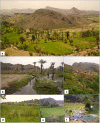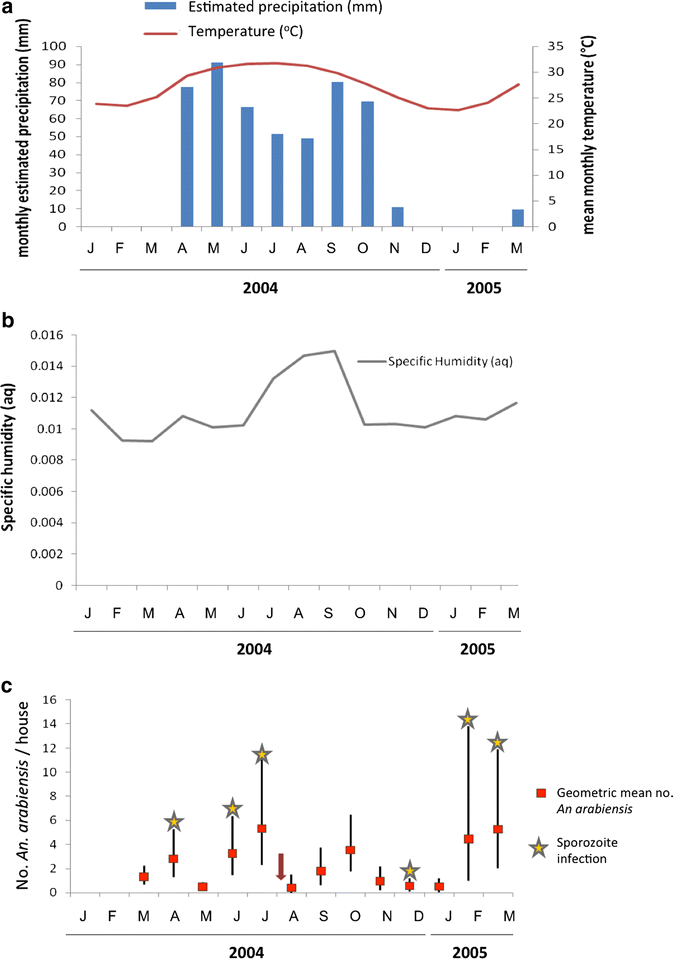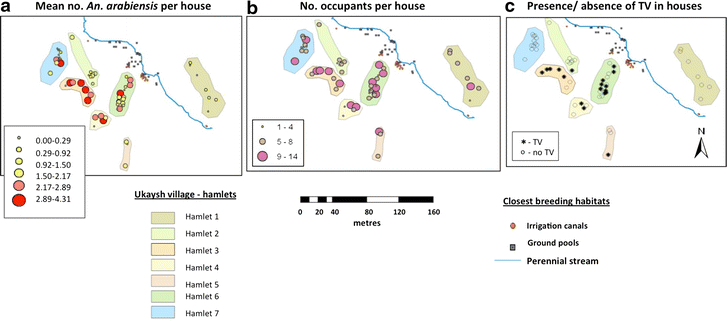Entomological aspects and the role of human behaviour in malaria transmission in a highland region of the Republic of Yemen
- PMID: 26932794
- PMCID: PMC4774125
- DOI: 10.1186/s12936-016-1179-8
Entomological aspects and the role of human behaviour in malaria transmission in a highland region of the Republic of Yemen
Abstract
Background: The Republic of Yemen has the highest incidence of malaria in the Arabian Peninsula, yet little is known of its vectors or transmission dynamics.
Methods: A 24-month study of the vectors and related epidemiological aspects of malaria transmission was conducted in two villages in the Taiz region in 2004-2005.
Results: Cross-sectional blood film surveys recorded an overall malaria infection rate of 15.3 % (250/1638), with highest rates exceeding 30 % in one village in May and December 2005. With one exception, Plasmodium malariae, all infections were P. falciparum. Seven Anopheles species were identified among 3407 anophelines collected indoors using light traps (LT) and pyrethrum knockdown catches (PKD): Anopheles arabiensis (86.9 %), An. sergentii (9 %), An. azaniae, An. dthali, An. pretoriensis, An. coustani and An. algeriensis. Sequences for the standard barcode region of the mitochondrial COI gene confirmed the presence of two morphological forms of An. azaniae, the typical form and a previously unrecognized form not immediately identifiable as An. azaniae. ELISA detected Plasmodium sporozoites in 0.9 % of 2921 An. arabiensis (23 P. falciparum, two P. vivax) confirming this species as the primary malaria vector in Yemen. Plasmodium falciparum sporozoites were detected in An. sergentii (2/295) and a single female of An. algeriensis, incriminating both species as malaria vectors for the first time in Yemen. A vector in both wet and dry seasons, An. arabiensis was predominantly anthropophilic (human blood index = 0.86) with an entomological inoculation rate of 1.58 infective bites/person/year. Anopheles sergentii fed on cattle (67.3 %) and humans (48.3; 20.7 % mixed both species), but only 14.7 % were found in PKDs, indicating predominantly exophilic behaviour. A GIS analysis of geographic and socio-economic parameters revealed that An. arabiensis were significantly higher (P < 0.001) in houses with televisions, most likely due to the popular evening habit of viewing television collectively in houses with open doors and windows.
Conclusions: The predominantly indoor human biting vectors recorded in this study could be targeted effectively with LLINs, indoor residual spraying and/or insecticide-treated window/door curtains reinforced by education to instil a perception that effective and affordable malaria prevention is achievable.
Figures





Similar articles
-
Effect of rice cultivation on malaria transmission in central Kenya.Am J Trop Med Hyg. 2008 Feb;78(2):270-5. Am J Trop Med Hyg. 2008. PMID: 18256428
-
Malaria case in Madagascar, probable implication of a new vector, Anopheles coustani.Malar J. 2015 Dec 1;14:475. doi: 10.1186/s12936-015-1004-9. Malar J. 2015. PMID: 26620552 Free PMC article.
-
Differential contribution of Anopheles coustani and Anopheles arabiensis to the transmission of Plasmodium falciparum and Plasmodium vivax in two neighbouring villages of Madagascar.Parasit Vectors. 2020 Aug 26;13(1):430. doi: 10.1186/s13071-020-04282-0. Parasit Vectors. 2020. PMID: 32843082 Free PMC article.
-
Systematic review of sporozoite infection rate of Anopheles mosquitoes in Ethiopia, 2001-2021.Parasit Vectors. 2023 Nov 27;16(1):437. doi: 10.1186/s13071-023-06054-y. Parasit Vectors. 2023. PMID: 38008761 Free PMC article. Review.
-
Biology, distribution and control of Anopheles (Cellia) minimus in the context of malaria transmission in northeastern India.Parasit Vectors. 2016 Nov 15;9(1):585. doi: 10.1186/s13071-016-1878-6. Parasit Vectors. 2016. PMID: 27846911 Free PMC article. Review.
Cited by
-
Assessment and an updated list of the mosquitoes of Saudi Arabia.Parasit Vectors. 2019 Jul 19;12(1):356. doi: 10.1186/s13071-019-3579-4. Parasit Vectors. 2019. PMID: 31324201 Free PMC article.
-
Design of a novel intelligent computing framework for predictive solutions of malaria propagation model.PLoS One. 2024 Apr 18;19(4):e0298451. doi: 10.1371/journal.pone.0298451. eCollection 2024. PLoS One. 2024. PMID: 38635576 Free PMC article.
-
Priorities for Broadening the Malaria Vector Control Tool Kit.Trends Parasitol. 2017 Oct;33(10):763-774. doi: 10.1016/j.pt.2017.06.003. Epub 2017 Jun 28. Trends Parasitol. 2017. PMID: 28668377 Free PMC article. Review.
-
Plasmodium gametocyte carriage in humans and sporozoite rate in anopheline mosquitoes in Gondar zuria district, Northwest Ethiopia.PLoS One. 2024 Jul 1;19(7):e0306289. doi: 10.1371/journal.pone.0306289. eCollection 2024. PLoS One. 2024. PMID: 38950022 Free PMC article.
-
Population Genetics of Anopheles pretoriensis in Grande Comore Island.Insects. 2022 Dec 23;14(1):14. doi: 10.3390/insects14010014. Insects. 2022. PMID: 36661943 Free PMC article.
References
-
- WHO. World Malaria Report 2013. Geneva: World Health Organization; 2013. [http://www.who.int/malaria/publications/world_malaria_report_2013/en/]. Accessed 7 Jul 2014.
-
- Abdulsalam MQA, Mohammed AKM, Ahmed AA, Fong MY. Clinical situation of endemic malaria in Yemen. Trop Biomed. 2010;27:551–558. - PubMed
-
- NMCP. Yemen’s National Malaria Control and Elimination Strategic Plan (2011–2015). Sana’a: National Malaria Control Programme, Ministry of Health and Population. Republic of Yemen. 2010.
Publication types
MeSH terms
LinkOut - more resources
Full Text Sources
Other Literature Sources

